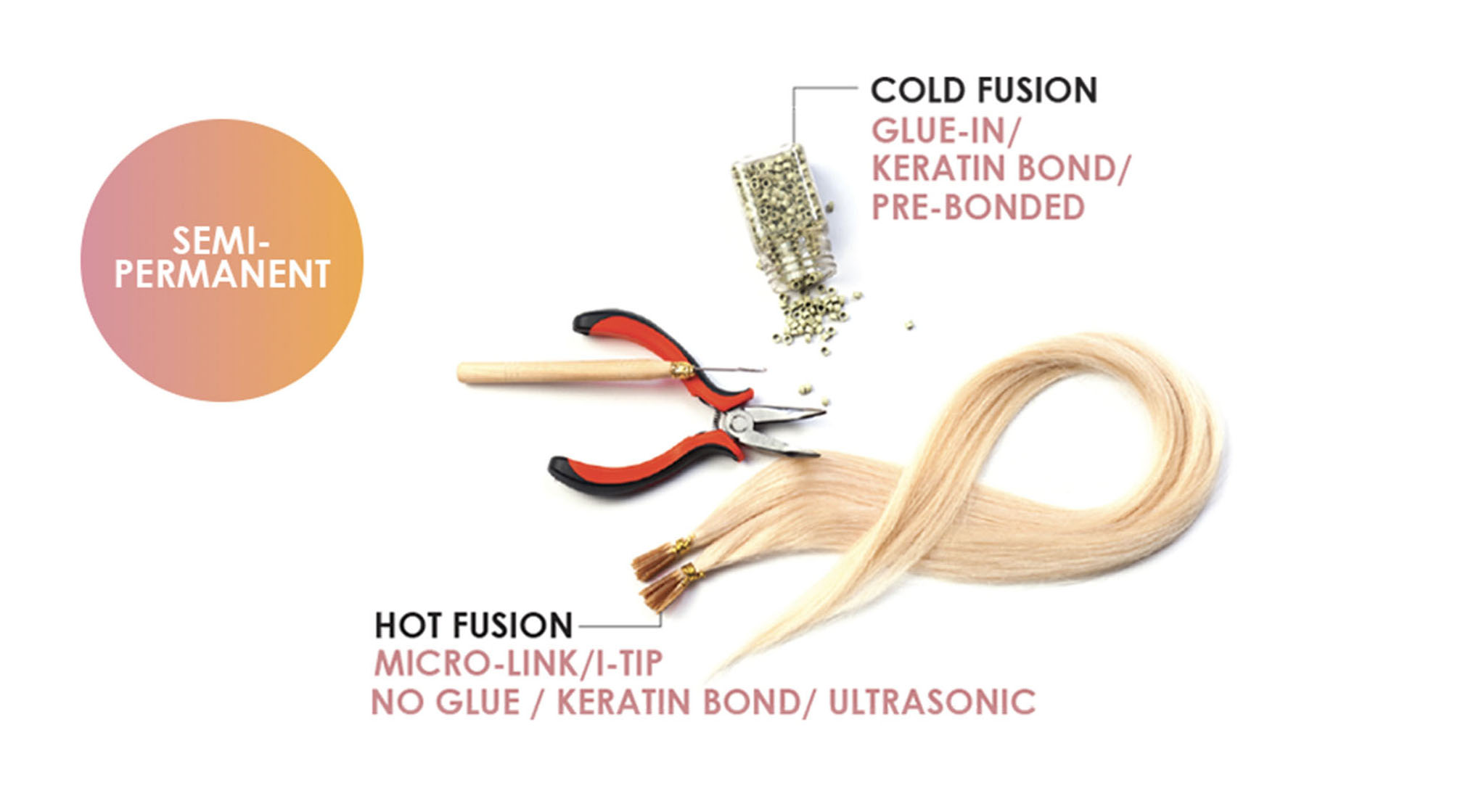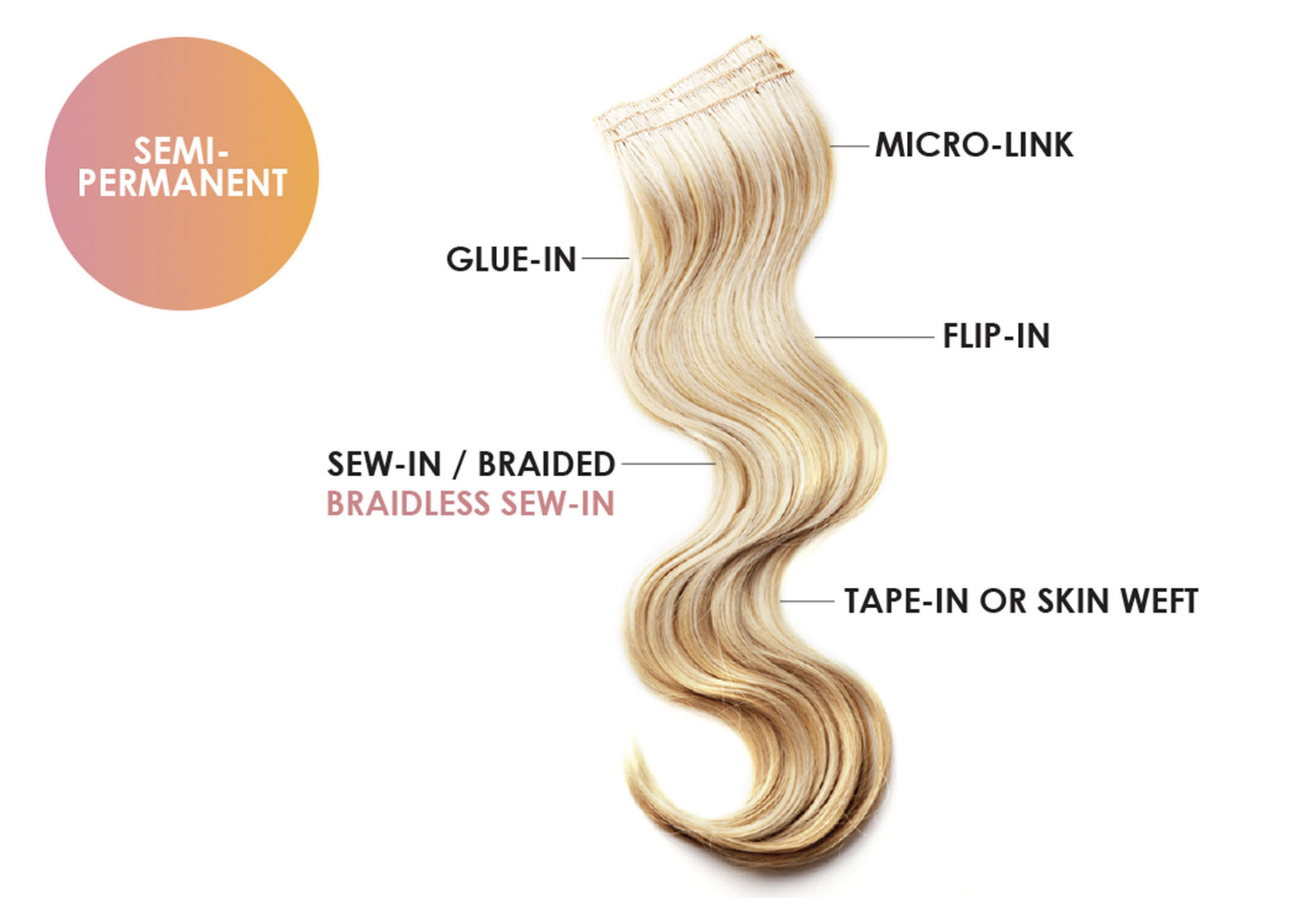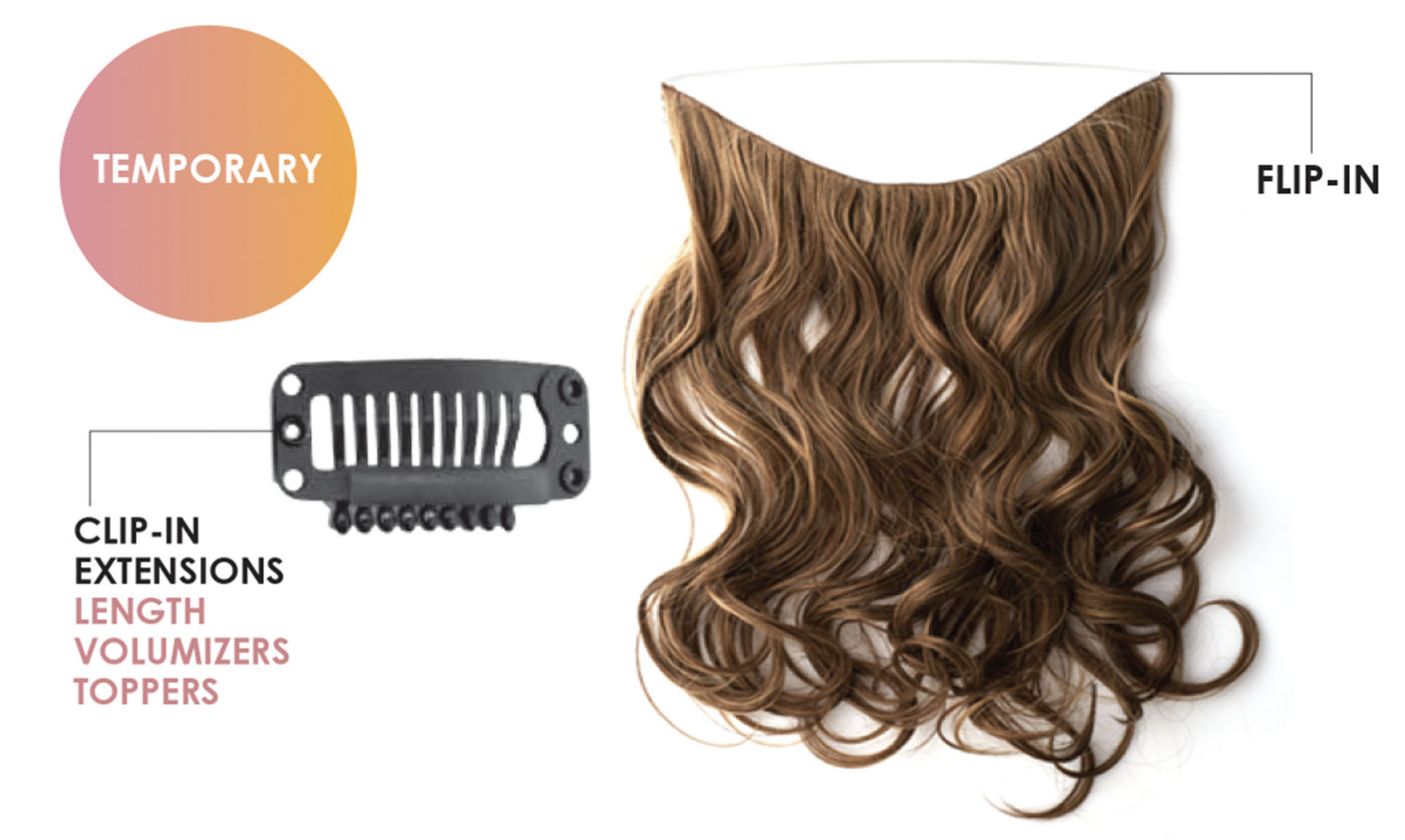Hair extension services are the most luxurious salon or retail hair service available and finding the best hair extensions for your hair type can be quite the task. It should be thought of as the most affordable facelift because fuller hair makes every woman look at least 5 years younger. In our humble opinion, most people don’t appreciate the luxury of access to 100% human hair whether for length, volume or chemical-free highlights.
While there are many different brands and types of hair extensions available it is important to remember that not all methods are created equal and the quality of the hair, craftsmanship, warranties etc. differs significantly from manufacturer to manufacturer.
Choosing a hair extension brand and method can be overwhelming but it is important that you choose the one that is best suited for you. This depends on several factors, including hair type, lifestyle, and budget.
Hair extension methods can be broken down into two different categories and each has various methods of attachment:
- Strand by strand – bonded, micro links and knotting.
- Wefted panels – tape in, clip in, flip in, sewn in and glued in.
Below you will find more information for the different methods, including, budget, pros, cons, and recommended maintenance:
Strand By Strand
The strand by strand method utilizes approximately 20 – 40 strands of hair, attached together at one end using a glue bond/keratin or polyurethane. Strand by strand extensions are attached to small pieces/sections of the wearer’s hair using a warm (bonded with a heat gun) or cold fusion (copper cylinders and plyers). Strand by strand systems are often referred to as a keratin bond, u or nail tip, flat tip or micro links and nanorings.
Bonded strand by strand are attached to the hair using a heating element. Your hair is placed between the U-tip and sealed with a hot extension tool which melts the Keratin glue which is rolled into the hair. The best bonds are attached close to the root allowing for a little space for movement. Volume applications use between 100 – 150 strands whereas length can require as many as 300 strands. The number of strands will depend on the amount and length of the wearer’s own hair, the desired look, and length.

The cost for strand by strand hair extensions depends on the brand, how many strands are added, and in which city they’re applied. Strand by strand is typically the most expensive method due to the lengthy application time; the national average is 6 – 8 hours.
-
- Most suitable for coarse, thick hair.
- Hair extensions can last between 16 – 20 weeks with proper maintenance, making this type of application the most durable.
-
- Durability can also be a con. 80% of hair extension damage occurs after the 8th week of wear, therefore, the longer you go the greater the chance of hair breakage and loss.
-
- The most expensive method of hair extensions due to the lengthy application and removal time.
-
- The most time-intensive application and removal. The national average application time is approximately 6 – 8 hours. Experienced hairdressers can complete a lengthening treatment in 2-4 hours.
-
- The attachment points, when cooled are hard and can be uncomfortable especially the first few weeks. Many wearers are agitated by the number of hard glue points in their hair.
-
- Not reusable hair which requires new hair purchased for every application.
-
- Heat is required for an application, which can not only be tough on the stylist’s hands but can lead to damage to the client’s hair. Continual rolling is not ergonomic for the hairdresser.
-
- The application requires the use of a special heating gun/tool/matching which can if incorrectly used burn the stylist and the client.
-
- Wearers often complain of a headache several days after application. You may also experience discomfort or an itchy scalp within the first couple weeks after application.
-
- The application requires a high learning curve for stylists, which may result in hair damage and breakage if not applied properly.
- If not maintained correctly and or brushed frequently the hair can look like extension hair as it clumps looking like “Spaghetti” hair.
Avoid any oil-based products or over-styling.
Cold Fusion, Micro-Links or I-tip:
Hair extension method where small sections of your hair are pulled through a small cylinder/bead/lock and clamped shut with a pair of plyers. Reputable companies use copper cylinders lined with silicone to protect your natural hair from breakage.
The cost for strand by strand hair extensions depends on the brand, how many strands are added, and in which city they’re applied.
- Since the extensions are individual strands, the hair moves a little more naturally.
- The application uses no heat or glue.
- Hair is reusable, and any extensions that may have slid down or off can be fixed in about an hour by an experienced technician.
- One of the timeliest methods of hair extensions, with a national average application time of 4-6 hours, whereas experienced stylists can complete in 2-3 hours.
Beads or locks can be visible if not placed appropriately and will slip more easily than any other method. - The attachment points are made out of copper making it hard which can be uncomfortable especially the first couple of weeks after application. Many wearers are agitated by the number of hard attachments in their hair.
- Wearers often complain of a headache several days after application if the application applies tension at the application point. You may also experience discomfort or an itchy scalp within the first couple weeks after application.
- Not suitable for thin, fine hair as the bonds can be visible through the hair.
- If the cooper points are not closed properly or precisely they will have sharp edges which can cut the hair.
- The application requires a high learning curve for a successful application and removal of this method, and if done incorrectly can cause hair breakage and damage.
- The application requires the use of a special tool used for clamping, and the constant squeezing motion is not ergonomic for the stylist.
Avoid use of oils or silicone-based products near the attachment.
Weft Extensions
A weft of hair is defined as a plurality of hair attached at one end. There are three types of wefts available, machine made, hand-tied or injection molded. Wefts vary in size from 1″ to 60″ but can be any length and are applied to the hair as panels in rows rather than as individual strands. Wefts can be applied using tape, clips glue, or sewn-in/braided method.

Tape in Extensions:
Tape in hair extensions are the newest method of extensions available. Polyurethane coated wefts/panels with double sided tape attached ranging between 1″ – 4″ long is applied on either side of the wearer’s hair “sandwiching” the user’s hair between two panels.
The cost for tape in extension can vary depending on the brand, type of hair, stylist’s application fee and the number of boxes or panels of hair.
- The safest method of hair extensions available as the weight of the panels is spread over a larger area causing no damage to the client’s hair.
- The fastest method of application. Volume applications take 10-30 minutes and full-length application 40-60 minutes.
- Reusable and the hair can be worn for up to 6-8 weeks per application, fitting into your salon visit cycle.
- Reusable method of extensions lasts between 6-8 weeks which fits into your salon visit cycle.
- Most natural looking hair extension method available.
- Most comfortable method of hair extensions.
- No heat or tools required for an application.
- The easiest method for hairdressers to learn which increases the likelihood of customer satisfaction.
- You can’t wash your hair or excessively sweat for 24-48 hours after application as the bond needs time to cure and adhere properly to the hair.
- The use of any silicone or oil-based products directly on the adhesive may cause the panels to slip.
- Some companies tape can be very tacky and messy during reapplication.
Avoid any silicone or oil-based products at the root of the hair. Brush hair daily from root to tip. Style hair as normal.
Hand-Tied Extensions:
Hand-tied hair extensions are ideal for people with thick and/or coarse hair. This method includes multiple rows of “hand-tied” wefts sewn to beaded attachment points which incorporate string/cotton yarn.
The cost depends on the cost of the hair and stylist’s application fee.
- Natural looking and lightweight.
- Comfortable and undetectable.
- Most suitable for thick, coarse hair.
- Can use oil-based products on the scalp.
- No heat or glue is required for an application.
- Tension points systems can lead to hair loss from traction alopecia.
- Damaging for women with thin fine hair and/or a shallow follicular funnel.
- Not suitable for women experiencing active hair loss.
- A difficult system to learn as it involves sewing and application can take several hours.
- If the hair extensions are not washed regularly, bacteria can build up and cause infection.
- Extensions may be uncomfortable, tight, and cause headaches after an application.
Wash hair regularly. Avoid over styling, as this can cause the braids to come loose. Shampoo, blow-dry, curl or straighten as you would with your normal hair for best results. Maintenance appointment for a move up every 4 – 8 weeks.
Glue-in:
Short-term hair extension method, where glue is applied to the base of the weft and attached to the hair. Wefts will only stay in the hair for a few days and can be removed using an oil-based solvent.
The cost for glue in extensions depends on the cost of the hair and stylist’s application fee.
- Suitable for someone looking to have extensions for a short amount of time without having to take the extensions in and out before bedtime.
- The least expensive form of hair extensions.
- Glue can cause damage to the hair if applied or removed incorrectly.
- The weight of thick wefts can cause headaches or tension alopecia.
- If the glue is applied to the scalp during application, the hair follicles can clog and cause bacterial scalp infections.
- Can only be used temporarily.
- Limited styling options.
Hair must be reapplied every few days or after you shower.
Sew-in or braided:
Commonly known as a weave, sew-in or braided extensions are ideal for coarse or thick hair. The client’s hair is braided to create a base for the extensions, and then wefts are sewn into the braids using a needle and thread. This method is commonly associated with ethnic hair wearers.
The cost for sew in or braided extensions depends on the cost of the hair and stylist’s application fee.
- Oil or silicone-based products may be used at the scalp as slipping will not occur unless the braids become loose.
- Most suitable for thick, coarse hair.
- No heat or glue is required for an application.
- Tight braids can cause hair loss from tension or traction alopecia.
- The application can take several hours.
- If the hair extensions are not washed regularly, bacteria can build up and cause infection.
- Extensions may be uncomfortable and cause headaches after an application.
- Limited hair styling options.
Wash hair regularly. Avoid over styling, as this can cause the braids to come loose. Shampoo, blow-dry curl or straighten as you would with your normal hair for best results.
Clip In
Clip in hair extensions is a temporary hair extension method, where wefts of hair are applied using small pressure sensitive clips. These are a great option for those who are not ready to commit to wearing extensions on a daily basis.

Most suitable for special occasions or events as the extensions can and will need to be removed before bedtime. If you prefer to not wear clip-ins, there are also hairpieces available that are attached using an undetectable wire. These clip-less extensions are often referred to as halo hair extensions.
The cost for clip in extensions depends on the type of hair, the brand the length and the weight of the hair.
- Greater versatility by having the option to apply and remove the hair on a daily basis.
- Non-commitment means you have the ability to change your hair color or style often.
- Hair can be taken in and out by the hair wearer, without having to go to a licensed cosmetologist.
- Clip in hair extensions cannot be worn by hair wearers for long periods of time and must be removed before bedtime.
- Clips clipped in the same place repetitively for extended periods of time can lead to hair loss.
- Not ideal for thin, fine hair as clips and base could be too bulky or heavy for the hair wearer.
- Unless used with proper care and maintenance, hair only lasts for a few months.
Wash hair extensions only when needed and apply a deep conditioner if the hair becomes dry or dull. Use a wide tooth comb or Loop brush to comb extensions. Brush before storing and store in a dark place, as prolonged exposure to light will fade the color.
